
Maintenance in the Realm of Flight Training

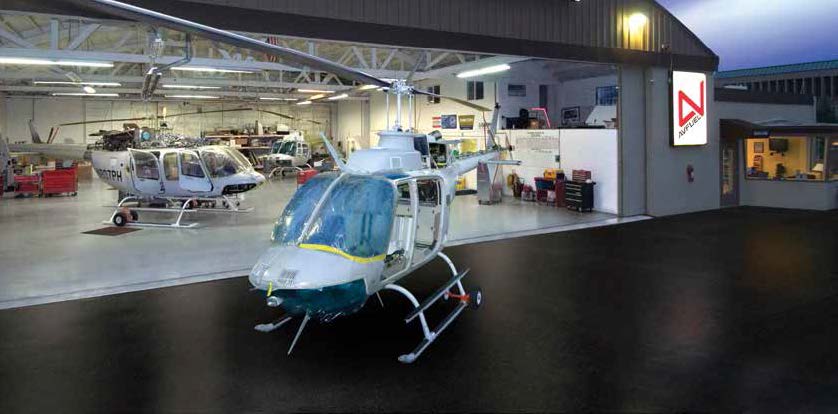
To fly is fantastic but to hover is divine. What a concept! As helicopter maintenance professionals we understand the sibling type of rivalry and jokes that exist between flight operations and maintenance. This is usually in good fun and good for morale. We know what we endured to get our ratings, but do we know what the pilots who fly our aircraft had to go through to get theirs?
Some of us might know that answer, some might not and others don’t care. Those who want to become pilots and fly helicopters as a career have to learn the basic skills of flying a helicopter. After all, we had to learn our skills to perform maintenance on the helicopters on which these wannabe pilots. Enter the world of maintenance in the helicopter flight training school environment.
Helicopter flight training schools often not only have many aircraft in their fleet to maintain and use as trainers, but they may also have numerous types of helicopters in that fleet. Hillsboro Aviation is a great example of one such flight training school.
History
Founded in 1980, the company was originally called Hillsboro Helicopters and began as a one-helicopter flight school in Hillsboro, OR, an agricultural town 15 miles west of Portland. As Hillsboro’s landscape changed with the introduction of several large technology companies, Hillsboro Helicopters steadily built its helicopter and airplane business. In 1992, Ed Cooley, former CEO and chairman of Precision Castparts Corporation, purchased the company. Precision Castparts, a Fortune 500 company and a leader for more than 40 years in the manufacturing of jet engine castings, blades and fans, continues to be one of Oregon’s largest companies.
Today, Hillsboro Aviation employs more than 250 people and is made up of three core business groups that consist of 16 separate revenue centers. The company’s fleet includes more than 90 aircraft that fly in excess of 68,000 flight hours annually. Hillsboro Aviation has established its position as a U.S. leader in helicopter sales and one of the largest combined helicopter and airplane flight training schools in the U.S., with thousands of graduates from more than 75 countries. Its charter division operates a fleet of Bell helicopters and Hawker Beechcraft King Airs throughout the U.S. Hillsboro Aviation is a dealer for Cessna and the Robinson Helicopter Company and also sells Bell helicopters. Hillsboro Aviation provides aircraft maintenance and avionics services, FBO fueling, aircraft parts and pilot supplies.
Facility
In 1980, Hillsboro Aviation opened its doors at the Hillsboro Airport (HIO) and began offering a variety of general aviation services. The Hillsboro facility currently serves as its primary base of operations and corporate headquarters, and consists of three hangars, an airplane ramp, a helicopter ramp and a charter ramp for visiting aircraft. In addition to serving as the head of operations for their charter, sales, service and flight school operations, the facility also offers an FAA-approved testing center, pilot store, pilot lounge, parts department, classrooms and charter lobby.
FAA-Approved Flight School
When a flight school is talked about as being an FAA Part 141-approved school or training under FAA Part 61, this refers to the federal regulations under which it has the authority to train pilots.
Part 141 regulations are related to the structure and approval of flight schools. Training under Part 141 regulations is permitted only by instructors associated with an FAA-approved flight school. In order to become approved, a flight school must meet certain requirements and submit each curriculum it wishes to have approved to the FAA for review. Part 141-approved schools are subject to regular surveillance audits by the FAA and must meet minimum pass rates on the practical exams to maintain their Part 141 approval status.
Both sets of regulations define minimum requirements for pilot training and certification. Both methods of flight training require the student to meet the same standard of performance in order to obtain a pilot certificate.
Where the methods differ is in rigidity and in some minimum requirements. Part 141 will usually offer lower minimum total flight hour experience for a particular course. Part 61 may offer advantages for students who start the courses with previous experience.
The determination of whether a student trains under Part 61 or Part 141 is based upon the most advantageous path for meeting the student’s flight training objective. The decision to conduct training under Part 61 regulations or Part 141 regulations should be evaluated for each certificate that a pilot receives for their training.
Any FAA-approved flight instructor, whether associated with a flight school or not, may train a student under Part 61 regulations.
Helicopter Flight Training
Hillsboro Aviation provides helicopter flight training for pilots interested in EMS, firefighting, external load, tour operations and a number of other exciting careers. They have been offering flight training courses since 1980 and their graduates have gone on to fly for companies all around the world.
It currently maintains a fleet of 35 training helicopters, including Robinson and Bell models. The fleet includes 22 Robinson R22s, two R44s, three Bell 206 JetRangers, three Bell 206 LongRangers, three Bell 407s and two Bell 205s.
Another key component of its training programs is to use the latest flight simulator technology. Its instructors are trained to use all available tools to help the student become a skilled pilot. Students receive dedicated, one-on-one training from their instructors, and they are committed to providing a quality education and real-world skills.
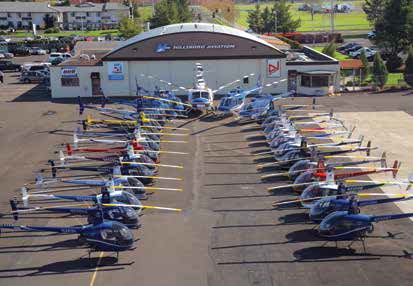
Interview
The following is from a talk with Seth Hansen, director of fleet maintenance at Hillsboro Aviation.
HMM– What kind of helicopter services do you provide?
Hansen– Our fleet maintenance department is solely focused on supporting our company flight operations. This department performs all of the line maintenance, inspections, Bell component overhauls, servicing and structural repair for our fleet. We are a factory-authorized service center for Bell, Cessna, Robinson and Lycoming, and in addition to servicing our own aircraft we provide maintenance and avionics services for customers across the western United States.
HMM– From how many different bases do you operate?
Hansen– Our turbine fleet operates all across the United States. Our flight school operations are primarily conducted out of our three campuses located in Hillsboro and Troutdale, OR, and our newest location in Prineville, OR.
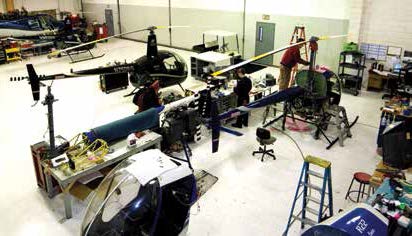
HMM– Focusing on the weather, how many days a year do you operate?
Hansen– We operate 364 days a year and are only closed on Christmas.
HMM– What is your mission statement?
Hansen– Hillsboro Aviation’s mission is to provide a pathway to quality aviation services in worldwide markets.
HMM– Does the maintenance department have a mission statement?
Hansen– To provide safe, regulatory, compliant aircraft maintenance services as efficiently as possible in support of company flight operations.
HMM – From a flying perspective, under what part FAR do you operate?
Hansen– Our aircraft operate under Parts 91, 133 and 135.
HMM– From a maintenance perspective, are you certified under a particular Part as a repair station?
Seth– We perform all of the maintenance for our aircraft as a Part 145 repair station.
HMM– What is a typical mission profile for the aircraft?
Hansen– It really depends. Our training aircraft are doing just that, but our turbine helicopters perform a variety of operations including scenic flights, power line survey, utility/external load operations, aerial construction, firefighting, search and rescue and LIDAR (the blending of two words light and radar). Some think it stands for light detection and ranging, but that is not correct.
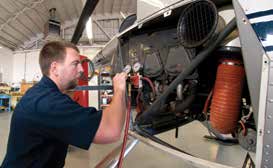
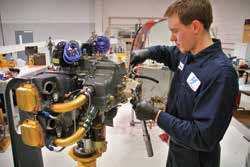
HMM– How many people are in your maintenance department by job description?
Hansen– We have 33 A&P mechanics, three avionics techs, three quality assurance personnel, eight parts persons and six supervisors.
HMM– What maintenance tasks are outsourced to an MRO or back to the OEM and why?
Hansen– We outsource all of our piston engine overhauls as well as some of our helicopter component overhauls. We are authorized to perform these tasks but we find it more cost effective to outsource that work.
HMM– From start to finish, what is the procedure for doing a maintenance repair or inspection?
Hansen– The basic outline for any scheduled or unscheduled repair would be as follows
1. Open a work order and determine work scope
2. Acquire any necessary tools, supplies, technical information and parts
3. Perform the maintenance in accordance with applicable technical information and regulations
4. Perform a final inspection and any operational checks required
5. Finalize and close out the work order paperwork
6. Return the aircraft to service and release to the flight department or for a maintenance check flight.
HMM– Of all the maintenance tasks that you perform, which have you found to be the most labor intensive and time consuming?
Hansen– Typically our most labor-intensive and time-consuming jobs are structural repairs due to the custom nature of these projects.
HMM– Do you have any lessons learned or tips you can share with our readers on a particular task that you found can improve on the maintenance process in the way of saving time, cost, materials, etc?
Hansen– In the last few years we have been working toward digitizing our systems to improve communication between departments and our service to the end customer. This has also helped us manage and correct issues that come with the high volume of work we perform. This movement towards digitalization has helped us become more efficient and safe.
HMM– Who performs pre-flight and post-flight inspections on the aircraft?
Hansen– The pilots perform the pre- and post-flight checks on the aircraft.
HMM– Who has the responsibility for assigning aircraft to flight operations?
Hansen– Aircraft assignments are made by our operations department, but maintenance may often be consulted for planning and equipment installations.
HMM– Who assigns the maintenance tasks to be done each day?
Hansen– The maintenance tasks are assigned either by our Part 135 director of maintenance or by the flight school shop lead for the campus where that work is being performed.
HMM– Please describe what takes place during a typical day in the life of the maintenance department.
Hansen– This varies significantly from day to day. Our fleet maintenance shop performs a very high volume of work in support of company flight operations. During the busy months of summer, our primary focus is keeping up with all of the scheduled and unscheduled maintenance throughout the day. During the winter we are focused on long-term maintenance and upgrades. This can include avionics and interior upgrades, paint or any other modifications that we decide to perform on the fleet.
HMM– If you were looking to hire a new mechanic, what skill sets would you be most interested in?
Hansen– If they are fresh out of school, we put a heavy emphasis on prior mechanical experience even if it is from other industries. If we are hiring a more experienced mechanic, we like to see prior experience on the specific airframes we operate.
HMM– Have you started any initiatives regarding the push towards a safety management system (SMS)?
Hansen– Hillsboro Aviation has a very active SMS that has been in use since 2009. We are the first helicopter training organization to receive International Standard for Business Aircraft Operators (ISBAO) accreditation. The ISBAO accreditation process involved an in-depth review of our SMS and how we are continually improving and developing a safety culture throughout the entire company. Safety is one of our core business functions. Hillsboro Aviation is committed to developing, implementing, maintaining and constantly improving strategies and processes. This helps ensure that all our aviation activities take place under a balanced allocation of organizational resources aimed at achieving the highest level of safety performance, meeting national and international standards while achieving our customer’s needs.
As you can see, Hillsboro Aviation offers a look at the realm of helicopter maintenance where prospective pilots not only learn how to fly, but how to do so divinely.
